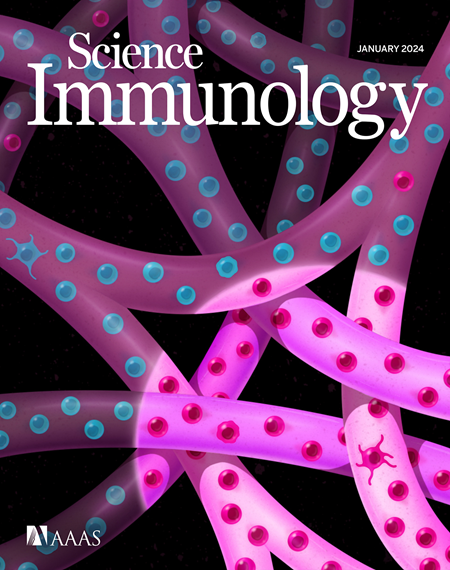形成孔隙的载脂蛋白 APOL7C 驱动吞噬体破裂和树突状细胞的抗原交叉呈递
IF 17.6
1区 医学
Q1 IMMUNOLOGY
引用次数: 0
摘要
传统的树突状细胞(cDCs)能产生针对细胞外病原体和肿瘤的保护性细胞毒性 T 淋巴细胞(CTL)反应。尽管XP具有重要的生物学意义,但其驱动机制仍不清楚。在这里,我们发现一种叫做脂蛋白 L 7C (APOL7C)的 cDC 特异性孔形成蛋白在先天性免疫刺激下上调,并被招募到吞噬体中。APOL7C 与吞噬体的结合导致吞噬体破裂,被吞噬的抗原逃逸到细胞膜,在细胞膜上通过内源性 MHC I 类抗原处理途径进行处理。因此,缺乏 APOL7C 的小鼠在对珠状抗原和细胞相关抗原进行免疫时不能有效地激发 CD8 + T 细胞。总之,我们的数据表明,存在一种专用的脂蛋白,它能介导将吞噬的蛋白质输送到活化的 cDCs 的细胞质中,从而促进 XP 的产生。本文章由计算机程序翻译,如有差异,请以英文原文为准。
The pore-forming apolipoprotein APOL7C drives phagosomal rupture and antigen cross-presentation by dendritic cells
Conventional dendritic cells (cDCs) generate protective cytotoxic T lymphocyte (CTL) responses against extracellular pathogens and tumors. This is achieved through a process known as cross-presentation (XP), and, despite its biological importance, the mechanism(s) driving XP remains unclear. Here, we show that a cDC-specific pore-forming protein called apolipoprotein L 7C (APOL7C) is up-regulated in response to innate immune stimuli and is recruited to phagosomes. Association of APOL7C with phagosomes led to phagosomal rupture and escape of engulfed antigens to the cytosol, where they could be processed via the endogenous MHC class I antigen processing pathway. Accordingly, mice deficient in APOL7C did not efficiently prime CD8+ T cells in response to immunization with bead-bound and cell-associated antigens. Together, our data indicate the presence of dedicated apolipoproteins that mediate the delivery of phagocytosed proteins to the cytosol of activated cDCs to facilitate XP.
求助全文
通过发布文献求助,成功后即可免费获取论文全文。
去求助
来源期刊

Science Immunology
Immunology and Microbiology-Immunology
CiteScore
32.90
自引率
2.00%
发文量
183
期刊介绍:
Science Immunology is a peer-reviewed journal that publishes original research articles in the field of immunology. The journal encourages the submission of research findings from all areas of immunology, including studies on innate and adaptive immunity, immune cell development and differentiation, immunogenomics, systems immunology, structural immunology, antigen presentation, immunometabolism, and mucosal immunology. Additionally, the journal covers research on immune contributions to health and disease, such as host defense, inflammation, cancer immunology, autoimmunity, allergy, transplantation, and immunodeficiency. Science Immunology maintains the same high-quality standard as other journals in the Science family and aims to facilitate understanding of the immune system by showcasing innovative advances in immunology research from all organisms and model systems, including humans.
 求助内容:
求助内容: 应助结果提醒方式:
应助结果提醒方式:


